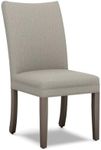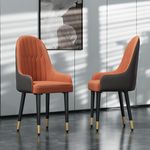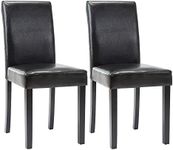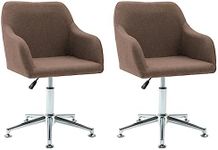Buying Guide for the Best Dining Chair For Heavy People
Choosing a dining chair for heavier individuals requires a thoughtful approach to ensure comfort, safety, and durability. It's important to look beyond just the style and color, and focus on the chair's construction, materials, and dimensions. The right chair should provide stable support, be comfortable for longer periods, and fit well with your dining space. Understanding the key specifications will help you make a confident and informed decision.Weight CapacityWeight capacity refers to the maximum amount of weight a chair is designed to safely support. This is crucial for heavier users, as exceeding the recommended limit can compromise safety and shorten the chair's lifespan. Weight capacities typically range from around 250 pounds to over 500 pounds. For heavier individuals, look for chairs with higher weight ratings, ideally with a comfortable margin above the user's weight. Always check the manufacturer's specifications and choose a chair that matches or exceeds your needs.
Frame MaterialThe frame material determines the chair's strength and durability. Common materials include wood, metal, and sometimes reinforced plastics. Metal frames, especially steel, tend to offer the highest strength and are less likely to warp or break under heavy use. Solid hardwoods are also strong but can vary depending on the type of wood and construction. If you need a chair for heavier use, prioritize metal or reinforced wood frames, and avoid lightweight or flimsy materials.
Seat Width and DepthSeat width and depth affect how comfortable the chair will be, especially for larger individuals. Standard dining chairs often have seat widths of 16-18 inches, but wider options (20 inches or more) provide more room and comfort. Depth is also important; a deeper seat can offer better support for longer legs, but too deep may be uncomfortable for shorter users. Consider the user's body size and shape, and choose a chair with dimensions that allow for comfortable sitting without feeling cramped.
Seat HeightSeat height is the distance from the floor to the top of the seat. Most dining chairs have a seat height of 17-19 inches, which works well with standard dining tables. However, for heavier individuals, a slightly higher seat can make sitting down and standing up easier. Make sure the seat height matches your table and allows for comfortable legroom. If possible, test different heights to find what feels best for you.
Cushioning and UpholsteryCushioning and upholstery impact both comfort and durability. Thicker, high-density foam cushions provide better support and last longer under heavier weight. Upholstery materials like leather, vinyl, or heavy-duty fabrics are more resistant to wear and easier to clean. If comfort is a priority, look for chairs with ample, firm padding and durable, easy-to-maintain covers.
Stability and Leg DesignStability is essential for safety, especially for heavier users. Chairs with wider bases, sturdy legs, and reinforced joints are less likely to wobble or tip. Some chairs have crossbars or additional supports between the legs for extra strength. When choosing, look for designs that feel solid and stable, and avoid chairs with thin legs or weak connections.












